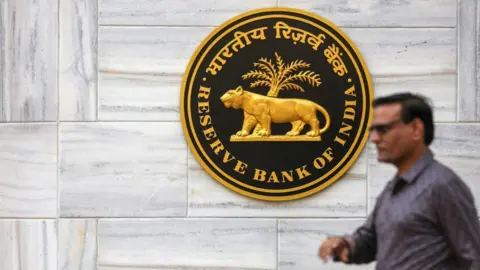India cuts rates as Trump's tariffs put growth at risk
 Getty Images
Getty ImagesIndia's central bank has cut interest rates by 0.25% amid a spate of downgrades to growth following Donald Trump's tariff announcements.
The Reserve Bank of India (RBI) reduced repo rates from 6.25% to 6%, a second cut since February when rates were brought down after nearly five years.
The repo rate is the level at which the central bank lends to commercial banks, influencing borrowing costs.
The RBI also brought down its growth projections for this year from 6.7% to 6.5%. It said India's gross domestic product (GDP) will grow at 6.5% next year as well.
Crucially, the RBI shifted its monetary policy stance to "accommodative" from "neutral", which means that the central bank would be more open to cutting rates in the future to stimulate a slowing economy.
"Concerns on trade frictions are coming true" and unsettling the global community, RBI governor Sanjay Malhotra said in his speech, adding that headwinds from disruptions to trade would continue to pose challenges for the economy.
Most economists who had previously expected only one more rate cut this year are now predicting more softening as Trump's tariff war puts growth in the world's fastest growing major economy at risk.
"The magnitude of rate cuts in the cycle now could be as high as 100bps (1%)," ICICI Bank said in a note, a view echoed by many other analysts.
Moderating inflation will give the RBI further elbow room to slash borrowing costs, according to several brokerages, as growth momentum further loses steam due to Trump's global trade war.
HSBC calculates GDP could take a direct hit of as much as half a percent this financial year due to slower export volumes around the world and weaker inflows of foreign funds.
The government's capacity to stimulate the economy to counter the impact of Trump's tariffs is also limited because "spending and tax revenues have lost steam in recent months", according to HSBC.
Starting Wednesday, Indian goods being exported to the US will face additional tariffs of up to 27%.
Tariffs on India are lower than 104% on China and 46% and 49% respectively on Vietnam and Cambodia.
The final impact on India's trade will depend on "how long the announced tariff structure lasts", ratings agency Crisil said. "The outcome will also be influenced by how other countries retaliate or negotiate with the US on tariffs."
China has already retaliated by imposing 34% reciprocal tariffs on US imports, while Europe is considering counter-measures.
India on the other hand has assumed a more restrained stance and is working towards concluding a trade deal with the US.
India has "agreed on the importance of the early conclusion of the Bilateral Trade Agreement", Foreign Minister S Jaishankar said on X (formerly Twitter) this week after his meeting with US Secretary of State Marco Rubio.
But even with a trade deal in place, India's economy is unlikely to be immune to a slowdown in other parts of the world with demand for its exports potentially reducing in the event of global growth falling off a cliff.
Wall Street bank JP Morgan has put the chance of a global recession at 60%, while ratings agency Moody's said the odds had risen from 15% to 35% due to tariffs.
At 6.5%, India continues to remain the world's fastest growing major economy, but its growth has sharply come off the 9.2% high recorded in financial year 2023-24.